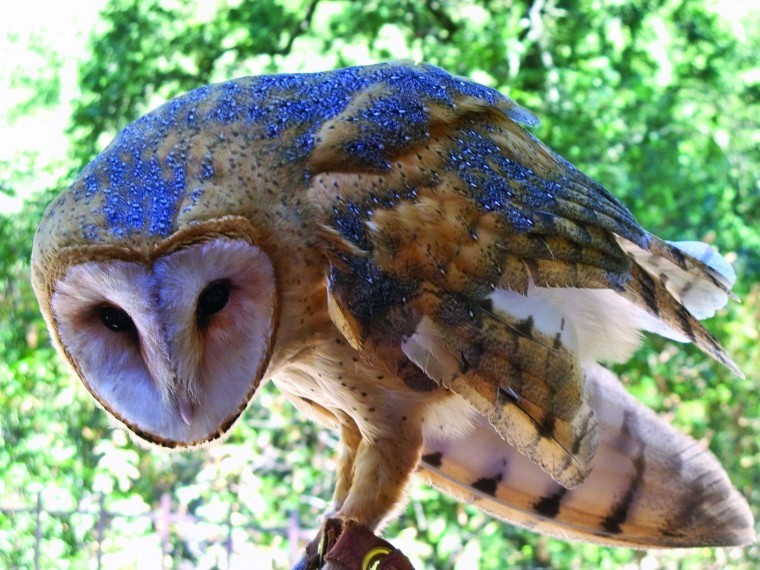Owls have had a variety of symbolic interpretations though the ages. Depending on your culture, it was believed that if you saw an owl it meant either that you could expect prosperity or that you’re going to die soon.
The Good
The owl is considered the “vahana” (transport) of the Hindu goddess of wealth, Lakshmi. The ancient Greeks and Romans saw owls as a symbol of wisdom and the goddess Athena/Minerva is depicted with an owl perched on her shoulder.
The Bad
Other cultures saw owls as harbingers of death. In some Native American tribes, for example, the owl was thought to swoop down in the night and steal souls. The Aztec god of death is sometimes pictured as being accompanied by owls. Of all of the owls, the barn owl in particular seems to be ill-omened. It’s been given the nicknames Demon Owl, Ghost Owl and Death Owl. Maybe it’s because they’re especially associated with late night and dark places. The Native American Newuk tribe believed that when an evil person died, he would become a barn owl. (On the other hand, if he led an honorable life, he would be reincarnated as a great horned owl).
As if to add injury to that insult, this adult barn owl was found last June on a residential driveway in Gilroy, unable to fly. X-rays indicated that the owl’s left wing was pinioned and the two metacarpals and phalanges (wrist and finger bones) and primary feathers were missing. Such mutilation is performed to deliberately cripple a bird in captivity, most often domestic ducks and geese to prevent them from flying away and escaping. Pinioning is not the same as clipping the feathers of pet birds such as parrots. Clipped feathers will grow back but amputating the bone itself is permanent and cannot be repaired surgically.
In the United States, it’s illegal to injure a migratory bird or keep one in captivity without a permit from the U.S. Fish and Wildlife Service. After notifying the USFWS and the California Department of Fish and Game of the incident, WERC filed an animal cruelty report with the Gilroy Police Department. The story was picked up by local and national media, as well as Fugitive Watch. The offender has never been identified, but WERC learned of a rumor that a couple of Halloweens ago in Gilroy, a live barn owl was seen perching upon the arm of an unknown person wearing a Harry Potter costume.
Because this barn owl had no wounds and her feathers were in good condition – except for the left wing mutilation, of course – it’s certain that the owl’s injury was not caused by an unfortunate accident or from mangling by a natural predator such as a raccoon or another raptor. For several months, the owl was kept under observation to ensure that the injury didn’t cause further pain or prevent her from freely ambulating in an enclosure.
By October, after being certified in good health by her veterinarian, this special bird was given the name Barnadette and officially joined WERC’s educational animal ambassador team. Barnadette lives in a large enclosure with a specially made ladder-ramp and extra perches so that she can hop up to her loft, where she sleeps during the day. Barnadette made her first public appearance at last year’s Taste of Morgan Hill and since then has been busy delighting local schoolchildren who are learning about silent hunters and other native wildlife.
Come spring, Barnadette will begin her second job as a foster mother to the many barn owlets that arrive every year after they’ve fallen out of their nests or been orphaned. Her presence will help prevent them from becoming imprinted on their human caretakers.
In last month’s animal story about Owlivia, I wondered why a screech owl is named that even though its voice is a pleasant trill. If any owl should be called a “screech owl” it would definitely be the barn owl whose voice is a blood-curdling shriek that must bring shivers to any nearby rodent. In fact, one of the barn owl’s many nicknames is “screech owl.” Other names refer to the barn owl’s appearance, voice or habitat: white owl, church owl, monkey-faced owl (personally, I prefer to call the bird a Valentine Owl because of its unusual heart-shaped face), hissing owl, golden owl, barnyard owl and rat owl.
The last nickname is especially pertinent. Barn owls are voracious predators of field scourges like rats, mice and gophers. A barn owl family of two adults and six young can consume more than 1,000 rodents during the three-month nesting period. Heavy vegetation and snow are no deterrence to their hunting – the barn owl is strictly nocturnal but has exceptional hearing and low-light vision, easily finding prey at night by sight and sound. They’re truly the BFF’s of farmers, ranchers and vintners year round.










